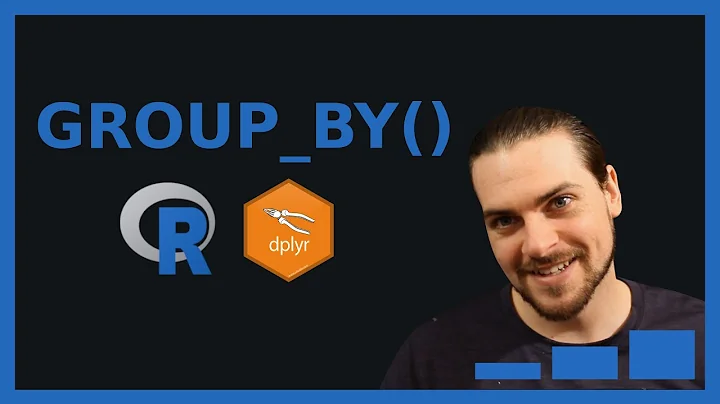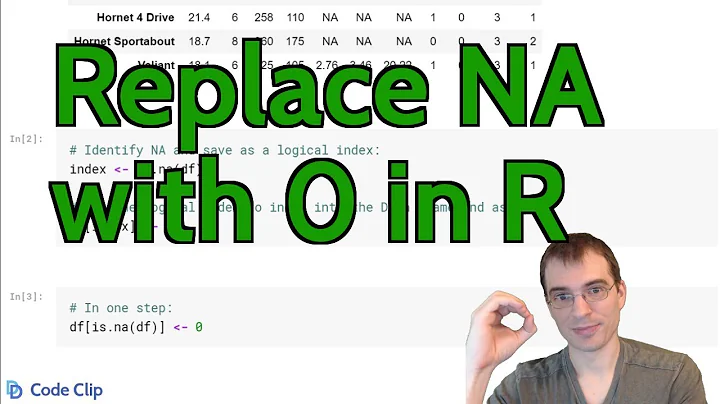Replace NA with previous or next value, by group, using dplyr
Solution 1
library(tidyr) #fill is part of tidyr
ps1 %>%
group_by(userID) %>%
#fill(color, age, gender) %>% #default direction down
fill(color, age, gender, .direction = "downup")
Which gives you:
Source: local data frame [9 x 4]
Groups: userID [3]
userID color age gender
<dbl> <fctr> <fctr> <fctr>
1 21 blue 3yrs F
2 21 blue 2yrs F
3 21 red 2yrs M
4 22 blue 3yrs F
5 22 blue 3yrs F
6 22 blue 3yrs F
7 23 red 4yrs F
8 23 red 4yrs F
9 23 gold 4yrs F
Solution 2
I wrote this function and it is definitely faster than fill and probably faster than na.locf:
fill_NA <- function(x) {
which.na <- c(which(!is.na(x)), length(x) + 1)
values <- na.omit(x)
if (which.na[1] != 1) {
which.na <- c(1, which.na)
values <- c(values[1], values)
}
diffs <- diff(which.na)
return(rep(values, times = diffs))
}
Solution 3
Using zoo::na.locf directly on the whole data.frame would fill the NA regardless of the userID groups. Package dplyr's grouping has unfortunately no effect on na.locf function, that's why I went with a split:
library(dplyr); library(zoo)
ps1 %>% split(ps1$userID) %>%
lapply(function(x) {na.locf(na.locf(x), fromLast=T)}) %>%
do.call(rbind, .)
#### userID color age gender
#### 21.1 21 blue 3yrs F
#### 21.2 21 blue 2yrs F
#### 21.3 21 red 2yrs M
#### 22.4 22 blue 3yrs F
#### 22.5 22 blue 3yrs F
#### 22.6 22 blue 3yrs F
#### 23.7 23 red 4yrs F
#### 23.8 23 red 4yrs F
#### 23.9 23 gold 4yrs F
What it does is that it first splits the data into 3 data.frames, then I apply a first pass of imputation (downwards), then upwards with the anonymous function in lapply, and eventually use rbind to bring the data.frames back together. You have the expected output.
Solution 4
Using @agenis method with na.locf() combined with purrr, you could do:
library(purrr)
library(zoo)
ps1 %>%
slice_rows("userID") %>%
by_slice(function(x) {
na.locf(na.locf(x), fromLast=T) },
.collate = "rows")
Solution 5
A few years down the line, I found that things have changed. Using @Steven Beaupré's approach,
1) Adding na.rm=F ensures no rows are deleted/excluded.
2) The slide_rows() function can be found in the purrrlyr package.
library(purrrlyr)
library(zoo)
ps1 %>%
slice_rows("userID") %>%
by_slice(function(x) {
na.locf(na.locf(x, na.rm=F), fromLast=T, na.rm=F) },
.collate = "rows")
Related videos on Youtube
Tarak
Updated on March 03, 2020Comments
-
Tarak about 4 years
I have a data frame which is arranged by descending order of date.
ps1 = data.frame(userID = c(21,21,21,22,22,22,23,23,23), color = c(NA,'blue','red','blue',NA,NA,'red',NA,'gold'), age = c('3yrs','2yrs',NA,NA,'3yrs',NA,NA,'4yrs',NA), gender = c('F',NA,'M',NA,NA,'F','F',NA,'F') )I wish to impute(replace) NA values with previous values and grouped by userID In case the first row of a userID has NA then replace with the next set of values for that userid group.
I am trying to use dplyr and zoo packages something like this...but its not working
cleanedFUG <- filteredUserGroup %>% group_by(UserID) %>% mutate(Age1 = na.locf(Age), Color1 = na.locf(Color), Gender1 = na.locf(Gender) )I need result df like this:
userID color age gender 1 21 blue 3yrs F 2 21 blue 2yrs F 3 21 red 2yrs M 4 22 blue 3yrs F 5 22 blue 3yrs F 6 22 blue 3yrs F 7 23 red 4yrs F 8 23 red 4yrs F 9 23 gold 4yrs F-
 Ronak Shah over 7 yearsSee if this is helpful. Replacing NAs with latest non-NA value or this replace NA value with the group value
Ronak Shah over 7 yearsSee if this is helpful. Replacing NAs with latest non-NA value or this replace NA value with the group value
-
-
Steven Beaupré over 7 yearsYou could replace
do.call()with the more idiomaticbind_rows()andsplit(ps1$userID)withsplit(.$userID) -
Steven Beaupré over 7 yearsAnother alternative using
purrrcould also be:library(purrr); ps1 %>% slice_rows("userID") %>% by_slice(function(x) { na.locf(na.locf(x), fromLast=T) }, .collate = "rows") -
 agenis over 7 years@StevenBeaupré nice! that deserves a new answer on its own ;-)
agenis over 7 years@StevenBeaupré nice! that deserves a new answer on its own ;-) -
Ritchie Sacramento about 4 yearsThe
fill()function has since been updated to allow filling in both directions at once instead of needing to use it twice. The.directionoptions now includedownupandupdown. -
Johannes Ranke over 3 yearsThank you for sharing your code which is independent of a grouping variable (which I do not have in my data) and does not require installing the zoo package.
-
Johannes Ranke over 3 yearsExcept that I am using tidyr anyways, and I discovered that tidyr::fill does the job more elegantly using the pipe, without the need to use mutate().
-
 Amit about 3 yearswhat if your data set is huge and you cant write each columns name
Amit about 3 yearswhat if your data set is huge and you cant write each columns name -
Pake over 2 years@Amit You can use fill(everything()) to fill all columns








